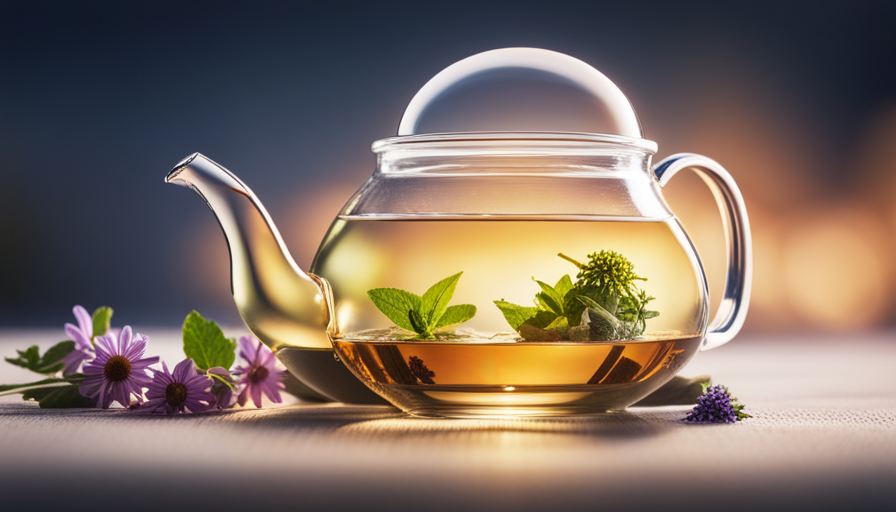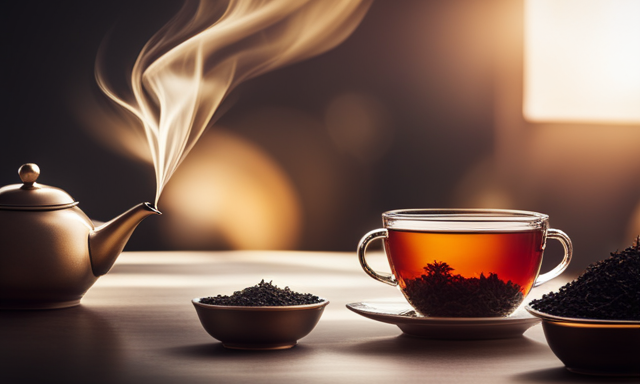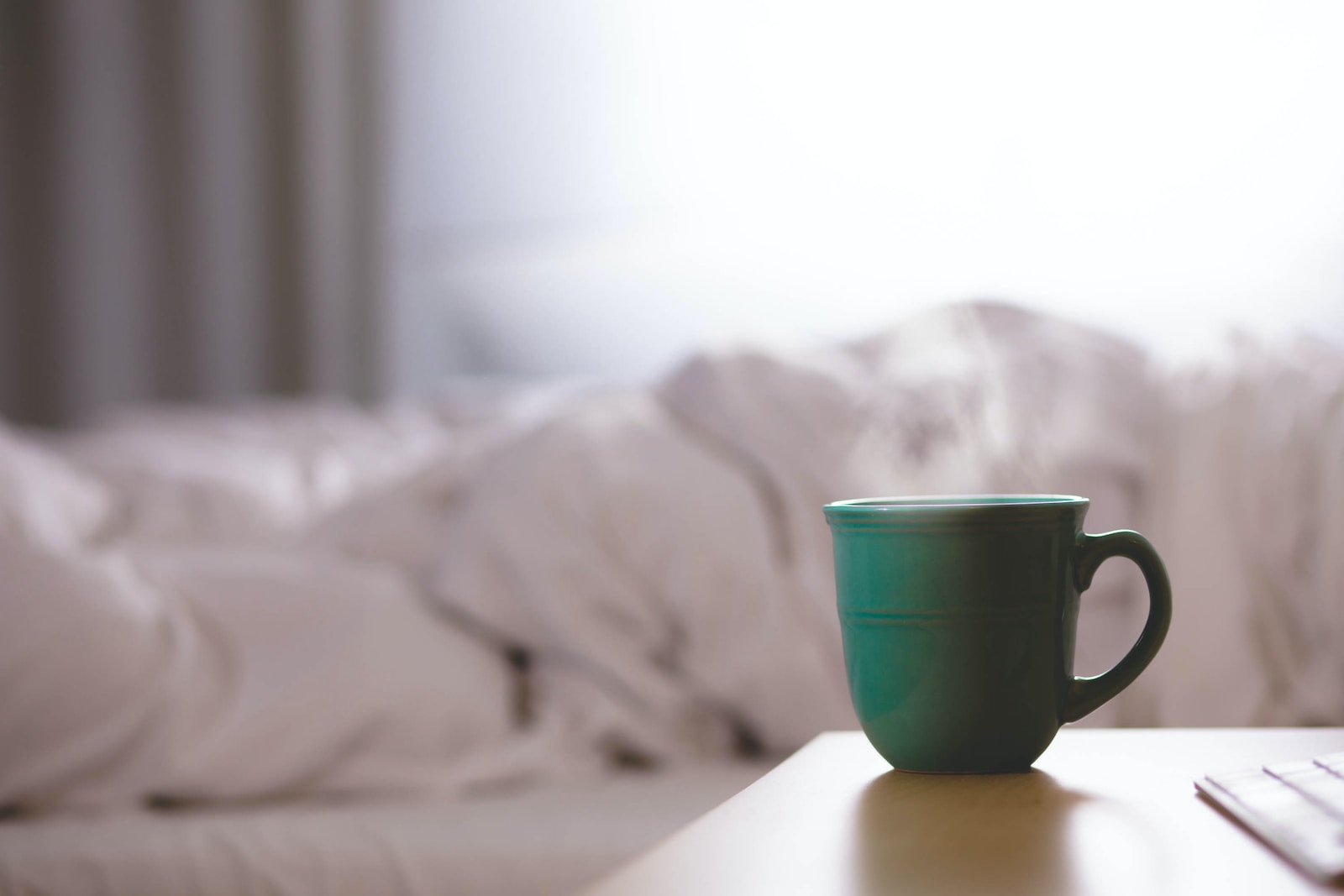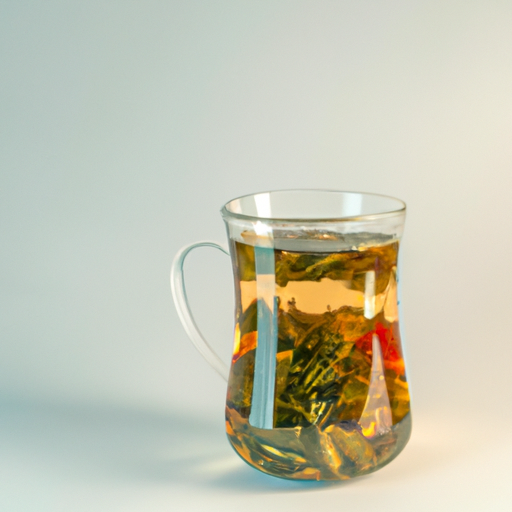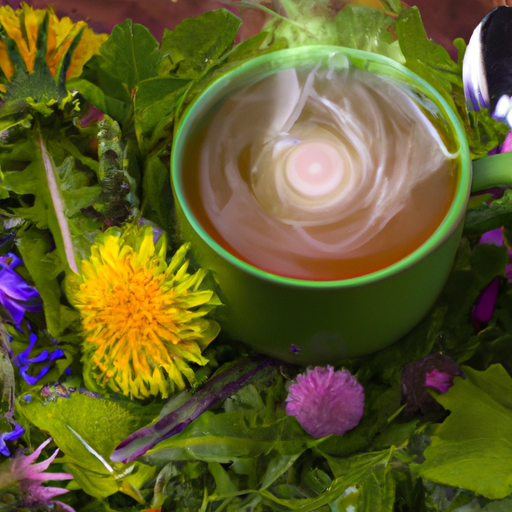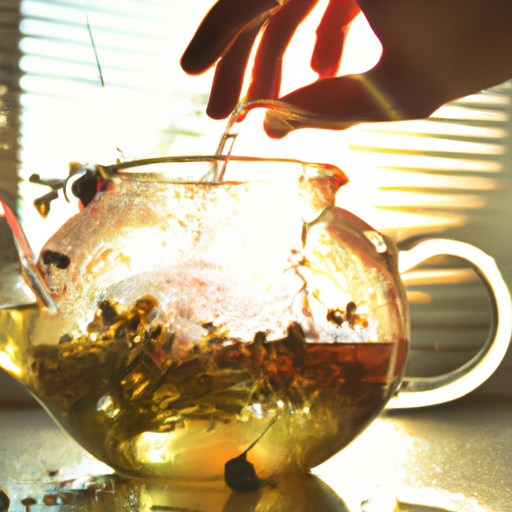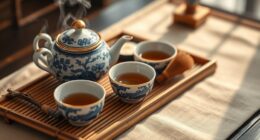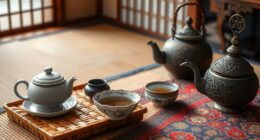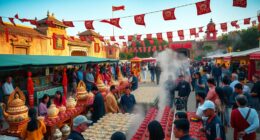Imagine making a cup of herbal tea is just a matter of pouring hot water over a tea bag and waiting a few minutes? Think again! Get ready to elevate your taste buds.
Because when it comes to steeping herbal tea, the temperature is everything. Yes, you heard me right. The temperature.
So, if you want to elevate your tea-drinking experience to a whole new level, buckle up and let me guide you through the world of proper tea steeping.
In this article, we’ll explore the importance of temperature control, understand the different types of herbal tea, and learn how to choose the right temperature for steeping.
We’ll also delve into the effects of temperature on flavor and aroma, introduce some handy tools and techniques for temperature control, and provide you with tips for achieving that perfect cup of herbal tea.
So get ready to sip your way to tea heaven.
Key Takeaways
- Steeping time is crucial for unlocking the full flavor and benefits of herbal tea.
- Different herbal teas require different steeping temperatures.
- Temperature control is essential for achieving optimal taste and aroma in herbal tea.
- Adjusting steeping time based on temperature can help achieve the desired flavor profile.
The Importance of Proper Tea Steeping
Proper tea steeping is essential for unlocking the full flavor and benefits of herbal tea. The role of steeping time can’t be overstated.
Each type of herbal tea requires a specific steeping time to bring out its unique flavors and properties. If you steep the tea for too short a time, you may end up with a weak and underwhelming brew. On the other hand, if you steep it for too long, the tea can become bitter and overpowering. Finding the perfect steeping time may require some trial and error, as different herbal teas vary in their optimal steeping durations.
Another crucial factor in proper tea steeping is choosing the best herbal tea for steeping. With so many options available, it can be overwhelming to know which one to choose. Consider your personal preferences and health goals when making a selection. For example, if you’re looking for a calming tea, chamomile or lavender may be good choices. If you want a tea to boost your immune system, echinacea or elderberry could be beneficial. Understanding the different types of herbal tea and their specific benefits will help you make an informed decision.
Now that we’ve covered the importance of proper tea steeping and how to choose the best herbal tea, let’s delve into understanding the different types of herbal tea.
Understanding the Different Types of Herbal Tea
When it comes to herbal tea, it’s important to understand the difference between herbal tea and true tea.nnHerbal tea is not made from the Camellia sinensis plant like true tea, but rather from a variety of herbs, flowers, and other plants.nnThere are many popular varieties of herbal tea, each with its own unique flavor and potential health benefits.
Herbal Tea vs. True Tea
If you’re looking for a refreshing beverage that’s caffeine-free, herbal tea is the way to go. Unlike true tea, which contains caffeine and originates from the Camellia sinensis plant, herbal tea is made from various herbs, fruits, flowers, and spices. It offers a wide range of flavors and benefits, making it a popular choice among tea lovers.
Herbal tea is known for its calming properties, aiding in digestion, boosting the immune system, and promoting relaxation. When it comes to brewing techniques, herbal tea requires a slightly different approach compared to true tea. The general rule of thumb is to steep herbal tea in boiling water for about 5 to 10 minutes, allowing the flavors to fully infuse.
Now that we understand the difference between herbal tea and true tea, let’s explore the popular varieties of herbal tea.
Popular Varieties of Herbal Tea
One of the most enjoyable aspects of herbal tea is the wide range of flavors and benefits it offers. From soothing chamomile to invigorating peppermint, there’s a popular herbal tea blend for every palate.
Herbal teas aren’t just delicious but also have numerous health benefits. For example, chamomile tea is known for its calming properties and can help with sleep and relaxation. Ginger tea is great for digestion and can alleviate nausea. And green tea, though technically not an herbal tea, is packed with antioxidants that promote overall wellness.
These popular herbal tea blends provide a delightful and beneficial experience for tea enthusiasts.
Now, let’s move on to the next section and delve into the art of choosing the right temperature for steeping herbal tea.
Choosing the Right Temperature for Steeping
To steep your herbal tea perfectly, you’ll want to ensure you choose the right temperature, as if you’re a tea connoisseur seeking the ultimate flavor profile.
Understanding steeping methods and the benefits of temperature control is crucial in achieving the desired taste and aroma. Different herbal teas require different temperatures to bring out their unique characteristics.
For delicate herbs like chamomile and lavender, a lower temperature of around 175°F (80°C) is recommended. This gentle heat helps preserve the delicate flavors and aromas without overpowering them.
On the other hand, robust herbs like peppermint and ginger can handle higher temperatures of around 200°F (93°C) to extract their full-bodied flavors.
By adjusting the temperature according to the type of herbal tea, you can ensure optimal taste and aroma. Remember, steeping tea is an art, and temperature control plays a crucial role in achieving the perfect cup.
Understanding the effects of temperature on flavor and aroma will further enhance your tea brewing skills and allow you to appreciate the nuances of each herbal tea variety.
The Effects of Temperature on Flavor and Aroma
When it comes to brewing herbal tea, the temperature plays a crucial role in determining its taste. The right temperature can extract the perfect balance of flavors, while a too high or too low temperature can result in a dull or bitter taste.
By understanding how different temperatures impact the taste of herbal tea, one can maximize its aroma and enjoy a more flavorful cup.
How Temperature Impacts Herbal Tea Taste
As the water heats up, the flavors of the herbal tea dance and meld together, creating a delightful sensory experience. The temperature and infusion time play a crucial role in unlocking the full potential of the herbal tea. Here are three key points to consider when it comes to brewing techniques and temperature:
-
Optimal temperature: Different herbal teas require different temperatures for steeping. For delicate herbal teas like chamomile or mint, a lower temperature around 175°F (80°C) is recommended. Stronger herbal teas like ginger or hibiscus can withstand higher temperatures around 200°F (93°C).
-
Steeping time: The infusion time varies depending on the desired strength and flavor intensity. Generally, herbal teas need to steep for 5 to 7 minutes to extract their full flavor. However, certain herbal teas may require longer steeping times for a more robust taste.
-
Preheating the teapot: To maintain the desired temperature throughout the steeping process, preheating the teapot is essential. This helps to prevent rapid cooling and ensures a consistent infusion.
By understanding the importance of brewing techniques and temperature, you can maximize the aroma and flavor of your herbal tea. Transitioning into the subsequent section about maximizing aroma with the right temperature, let’s explore how temperature can enhance the overall sensory experience.
Maximizing Aroma with the Right Temperature
The right temperature can bring out the full fragrance of your brew, enveloping your senses in a delightful olfactory journey. Maximizing aroma in herbal tea is all about temperature control.
Different herbs release their flavors and aromas at specific temperatures, and it’s crucial to find the sweet spot for each type of tea. Too hot, and you risk scorching the delicate flavors; too cold, and the tea may lack depth. By using the right temperature, you can unlock the full potential of the herbs, allowing their natural scents to permeate the air and tantalize your taste buds.
Achieving the perfect temperature requires precision and attention to detail, but the results are well worth it.
Now, let’s delve into the tools and techniques for temperature control, which will further enhance your herbal tea experience.
Tools and Techniques for Temperature Control
When it comes to controlling the temperature of our tea, there are a few key tools and techniques that can help us achieve the perfect brew. First and foremost, using a thermometer or an electric kettle with temperature control settings can ensure that we’re steeping our tea at the desired temperature. This is crucial because different types of tea require different temperatures to bring out their best flavor and aroma.
Additionally, it’s important to consider the relationship between steeping time and temperature adjustment. Adjusting the steeping time based on the temperature can help us achieve the desired flavor profile, as higher temperatures may require shorter steeping times and vice versa.
By utilizing these tools and techniques, we can have more control over our tea brewing process and enjoy a cup of tea that’s precisely steeped to perfection.
Using a Thermometer or Electric Kettle
Using a thermometer or an electric kettle is like having a compass to navigate the perfect temperature for steeping herbal tea. When it comes to thermometer accuracy, using a reliable thermometer ensures that you’re able to achieve the optimal temperature for your herbal tea.
This is important because different herbs require different temperatures to release their flavors and beneficial properties. An electric kettle is a great tool to have because it allows for precise temperature control, ensuring that you can easily reach and maintain the desired temperature. Additionally, an electric kettle heats up quickly, saving you time and energy.
Now that we’ve established the importance of temperature control, let’s explore how steeping time can be adjusted based on the temperature to further enhance the flavor and benefits of your herbal tea.
Steeping Time vs. Temperature Adjustment
To maximize the flavor and benefits of your brew, you’ll want to consider adjusting the steeping time based on the temperature at which you’re steeping your favorite herbal blend. This is because different temperatures extract different compounds from the herbs, resulting in varying flavors and strengths.
Here are four key points to keep in mind when it comes to steeping duration and temperature adjustment:
- Higher temperatures generally require shorter steeping times to avoid over-extraction and a bitter taste.nn2. Lower temperatures may necessitate longer steeping times to fully extract the flavors and benefits of the herbs.nn3. Delicate herbs, such as chamomile or lavender, should be steeped at lower temperatures for a shorter duration to preserve their delicate flavors.nn4. Robust herbs, like peppermint or ginger, can withstand higher temperatures and longer steeping times to release their full-bodied essence.
By understanding the relationship between steeping duration and temperature adjustment, you can tailor your brewing process to suit your personal preferences.
Now, let’s delve into experimenting with temperature for a more customized tea experience.
Experimenting with Temperature for Personal Preference
For the best results, try steeping your herbal tea at different temperatures to discover your personal preference. Experimenting with temperature can greatly impact the flavor and strength of your tea. By adjusting the water temperature, you can bring out different characteristics and nuances in the herbs, allowing you to tailor the taste to your liking.
To help you in your journey of finding the perfect temperature for your herbal tea, I have created a table below that outlines the recommended temperature range for different types of herbs. Keep in mind that these are general guidelines, and you may need to adjust the temperature based on your own taste preferences.
| Herb Type | Recommended Temperature Range |
|---|---|
| Chamomile | 200°F – 212°F |
| Peppermint | 200°F – 212°F |
| Lavender | 190°F – 200°F |
| Ginger | 190°F – 200°F |
| Hibiscus | 180°F – 190°F |
By experimenting with different temperature ranges within these guidelines, you can find the sweet spot that brings out the best flavors in your herbal tea. Once you have discovered your preferred temperature, you can move on to the next section where I will share some tips for achieving the perfect cup of herbal tea.
Tips for Achieving the Perfect Cup of Herbal Tea
For a flawless flavor, follow these tips to brew the ultimate cup of aromatic infusion.
-
Experiment with steeping time: Steeping time plays a crucial role in extracting the full potential of herbal tea flavors. I recommend starting with a shorter steeping time and gradually increasing it until you find your desired taste. This allows you to control the intensity of the flavors and avoid any bitterness or overpowering notes.
-
Enhance herbal flavors: To amplify the natural flavors of your herbal tea, consider adding complementary ingredients. For example, a slice of citrus fruit can add a refreshing zest, while a dash of honey can bring out the tea’s sweetness. Don’t be afraid to get creative and experiment with different combinations to find your perfect match.
-
Pay attention to water temperature: Each herbal tea variety has its own ideal steeping temperature. Generally, a temperature between 190-205°F (88-96°C) works well for most herbal teas. However, delicate flowers and herbs may require slightly lower temperatures to prevent scorching or loss of delicate flavors.
By choosing the right steeping time and enhancing the herbal flavors with thoughtful additions, you can create a truly exceptional cup of herbal tea. Now, let’s delve into the art of steeping herbal tea and explore the various techniques and methods to further elevate your tea experience.
The Art of Steeping Herbal Tea
After exploring various tips for achieving the perfect cup of herbal tea, I now delve into the art of steeping herbal tea. Steeping is a crucial step in the tea-making process, as it allows the flavors and aromas of the herbs to infuse into the hot water.
To maximize the aroma and achieve perfection in your cup of herbal tea, it’s important to pay attention to the temperature at which you steep. Different herbs have different optimal steeping temperatures, so it’s crucial to know the ideal temperature for the specific herbal tea you’re brewing.
Generally, herbal teas are steeped at a temperature between 200°F and 212°F (93°C and 100°C). However, delicate herbs like chamomile and lavender thrive at lower temperatures, around 180°F (82°C), while heartier herbs like peppermint and ginger can handle higher temperatures.
By steeping your herbal tea at the right temperature, you ensure that the flavors and aromas are released to their fullest potential, resulting in a deeply satisfying cup.
Now that we understand the art of steeping, let’s explore some common mistakes to avoid when preparing herbal tea to ensure a truly delightful experience.
Common Mistakes to Avoid when Steeping Herbal Tea
Beware the perilous pitfalls that await the unassuming tea enthusiast, for a single misstep in the delicate dance of steeping can shatter the dreams of a truly transcendent sipping experience. To avoid these common mistakes and maximize the aroma of your herbal tea, follow these simple guidelines:
-
Don’t oversteep: Leaving your herbal tea in hot water for too long can result in a bitter and unpleasant taste. Follow the recommended steeping time for your particular tea to achieve the perfect balance of flavors.
-
Use the right water temperature: Different herbal teas require different water temperatures for optimal extraction. As a general rule, use water that’s just below boiling (around 200°F or 93°C) for most herbal teas. This will help preserve the delicate flavors and aromas.
-
Cover your tea while steeping: Keeping your tea covered while it steeps helps retain the essential oils and flavors. This ensures that you get the full aromatic experience with every sip.
-
Avoid using metal infusers: Metal infusers can sometimes impart a metallic taste to your herbal tea. Opt for a non-reactive material like ceramic or glass to preserve the purity of the flavors.
By avoiding these common mistakes and paying attention to the temperature, you can elevate your herbal tea experience to new heights. Transitioning into the next section, let’s explore how the right temperature can further enhance your sipping pleasure.
Conclusion: Elevating Your Herbal Tea Experience with the Right Temperature
Indulge in the blissful culmination of flavors and aromas that await you when embracing the perfect temperature for your cup of herbal goodness. Temperature plays a crucial role in tea brewing, as it directly impacts the flavor profile of your brew. Understanding the impact of temperature on tea flavor will allow you to elevate your herbal tea experience to new heights.
To help you achieve the ideal temperature for steeping herbal tea, let’s take a look at the following table:
| Tea Type | Recommended Temperature |
|---|---|
| Chamomile | 200°F (93°C) |
| Peppermint | 212°F (100°C) |
| Ginger | 212°F (100°C) |
| Rooibos | 203°F (95°C) |
| Hibiscus | 212°F (100°C) |
By adhering to the recommended temperatures, you can unlock the full potential of each herbal blend. Steeping chamomile at 200°F will release its delicate floral notes, while peppermint and ginger require the full boiling point of 212°F to extract their bold flavors. Rooibos and hibiscus benefit from a slightly lower temperature, allowing their unique characteristics to shine.
The temperature at which you steep your herbal tea can make a world of difference. It affects the extraction of flavors, the release of aromas, and ultimately, the overall taste of your brew. So, take the time to understand the role of temperature in tea brewing, and embrace the perfect temperature to enhance your herbal tea experience.
Frequently Asked Questions
Can I use the same temperature to steep all types of herbal tea?
No, different types of herbal teas require different steeping methods and temperatures. One interesting statistic to consider is that chamomile tea should be steeped at a lower temperature of around 90°C (194°F) for optimal flavor extraction. On the other hand, peppermint tea benefits from a higher temperature of around 95°C (203°F).
It’s important to follow the recommended steeping times and temperatures for each herbal tea to achieve the best taste and health benefits.
How long should I steep herbal tea at different temperatures?
To get the best flavor and health benefits from herbal tea, it’s important to steep it at the right temperature for the right amount of time.
Steeping herbal tea at lower temperatures for longer durations allows the flavors to fully develop without releasing any bitter compounds. However, steeping at higher temperatures can result in a stronger flavor and quicker infusion, but it may also lead to a loss of some delicate health benefits.
Finding the right balance is key to enjoying the perfect cup of herbal tea.
What happens if I steep herbal tea at a higher temperature than recommended?
Steeping herbal tea at a higher temperature than recommended can have negative effects on its flavor and health benefits. For example, I once steeped chamomile tea at boiling temperature, and it turned out bitter and unpleasant. High temperature can cause the release of tannins and other compounds that result in a harsh taste. It can also degrade the delicate compounds in the tea, diminishing its potential health benefits.
It’s important to follow the recommended steeping temperature to enjoy the best flavor and benefits of herbal tea.
Can I use a regular kitchen thermometer to measure the temperature for steeping herbal tea?
Yes, you can use a regular kitchen thermometer to measure the temperature for steeping herbal tea. It’s important to steep herbal tea within the optimal temperature range to achieve the best flavor.
Factors such as water temperature, steeping time, and tea-to-water ratio can all affect the flavor of herbal tea during steeping. Using a thermometer allows you to accurately monitor and adjust the temperature, ensuring a perfect cup of herbal tea every time.
Are there any alternatives to using a thermometer for controlling the temperature while steeping herbal tea?
There are several alternatives to using a thermometer for controlling the temperature while steeping herbal tea. One method is to rely on the time it takes for the water to cool down after boiling.
Another option is to use visual cues, such as bubbles forming on the bottom of the pot or steam rising from the water.
Additionally, you can experiment with different water temperatures and steeping times to find the perfect balance of flavors for your herbal tea.
Conclusion
In conclusion, achieving the perfect cup of herbal tea is an art that requires attention to detail and a deep understanding of the steeping process. By choosing the right temperature and using the proper techniques, you can unlock the full potential of your herbal tea. This will allow its flavors and aromas to bloom like a beautiful garden in full bloom.
So remember, just like tending to a garden, nurturing your tea with the right temperature will result in a truly elevated and delightful tea experience.

